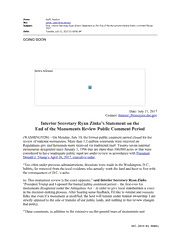Table Of ContentFrom: Swift, Heather
Bcc: james [email protected]
Subject: Fwd: Interior Secretary Ryan Zinke’s Statement on the End of the Monuments Review Public Comment Period:
TEST
Date: Tuesday, July 11, 2017 11:19:06 AM
GOING SOON
news release
Date: July 11, 2017
Contact: [email protected]
Interior Secretary Ryan Zinke’s Statement on the
End of the Monuments Review Public Comment Period
(WASHINGTON) – On Monday, July 10, the formal public comment period closed for the
review of national monuments. More than 1.2 million comments were received on
Regulations.gov and thousands more received via traditional mail. Twenty-seven national
monuments designated since January 1, 1996 that are more than 100,000 acres or that were
considered to have inadequate public input are under review in accordance with President
Donald J. Trump’s April 26, 2017, executive order.
“Too often under previous administrations, decisions were made in the Washington, D.C.,
bubble, far removed from the local residents who actually work the land and have to live with
the consequences of D.C.’s actio
ns. This monument review is the exact opposite,” said Interior Secretary Ryan Zinke.
“President Trump and I opened the formal public comment period – the first-ever for
monuments designated under the Antiquities Act – in order to give local stakeholders a voice
in the decision-making process. After hearing some feedback, I'd like to remind and reassure
folks that even if a monument is modified, the land will remain under federal ownership. I am
strictly opposed to the sale or transfer of our public lands, and nothing in this review changes
that policy.
“These comments, in addition to the extensive on-the-ground tours of monuments and
DOI-2019-01 00041
meetings with stakeholders, will help inform my recommendation on the monuments going
forward,” Zinke said. “I appreciate everyone who took the time to log-on or write in to
participate in our government.”
As required by the executive order, Secretary Zinke submitted an interim report in June to the
White House with various recommendations and observations on Bears Ears National
Monument, which recommended the monument be reduced in size to conform with the intent
of the Antiquities Act, that of designating the smallest compatible area. The report also
suggested the creation of a national conservation area and official co-management by the local
Tribal governments.
The report came after Zinke spent several days on the ground in Utah touring the monument
by air, car, foot and horseback, and speaking with stakeholders from Tribal, local, state and
federal government, and representatives from conservation, historic preservation, agriculture,
tourism and education sectors. The Secretary met with the Bears Ears InterTribal Coalition
while in Salt Lake City on May 7, and the Acting Deputy Secretary held a four-hour follow-up
meeting with the Bears Ears Commission and the InterTribal Coalition on May 25.
The Secretary also traveled to Maine’s Katahdin Woods and Waters National Monument and
to Boston to hold meetings on the Northeast Canyons and Seamounts National Marine
Monument off the coast of New England. The Secretary plans to visit Oregon, New Mexico
and Nevada in the coming weeks.
Regarding the comment period, the executive order stated:
In making the requisite determinations, the Secretary is directed to consider:
(i) the requirements and original objectives of the Act, including the Act’s requirement
that reservations of land not exceed “the smallest area compatible with the proper care
and management of the objects to be protected”;
(ii) whether designated lands are appropriately classified under the Act as “historic
landmarks, historic and prehistoric structures, [or] other objects of historic or scientific
interest”;
(iii) the effects of a designation on the available uses of designated Federal lands,
including consideration of the multiple-use policy of section 102(a)(7) of the Federal
Land Policy and Management Act (43 U.S.C. 1701(a)(7)), as well as the effects on the
available uses of Federal lands beyond the monument boundaries;
(iv) the effects of a designation on the use and enjoyment of non-Federal lands within or
beyond monument boundaries;
(v) concerns of State, tribal, and local governments affected by a designation, including
the economic development and fiscal condition of affected States, tribes, and localities;
(vi) the availability of Federal resources to properly manage designated areas; and
(vii) such other factors as the Secretary deems appropriate.
82 FR 20429-20430 (May 1, 2017).
DOI-2019-01 00042

